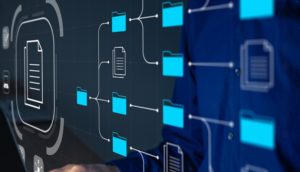
Five Ways ML Can Drive Enterprise-Wide Business Impact in the Era of Big Data

(metamorworks/Shutterstock)
While machine learning has been around–and growing more mainstream–for decades, its popularity is exploding in the era of big data with the market expected to expand at a 42% compound annual growth rate by 2024. With unprecedented amounts of data produced daily as the world becomes increasingly digitally connected, organizations need tools that help sift through and work with that extraordinary amount of data. Using machine learning, companies are building models that process massive volumes of data quickly and put it to good use in a myriad of ways.
If harnessed effectively, machine learning can make a massive organizational impact in five key ways: decision making, forecasting, personalization, boosting efficiency and managing assets.
Mastering Decision Making
Machine learning has revolutionized how businesses process and analyze data, reaching insights more quickly than ever before. The faster decision makers can receive insights, the faster they can make critical decisions. Often, the competitive edge is found in milliseconds rather than minutes or hours.
For example, machine-learning-based software trained to identify anomalies in a company’s security environment can detect a data breach instantly and notify the appropriate teams within the organization. The intelligence from these machine learning models enable those teams to make fast decisions about effective remediation, safeguarding customer data, upholding their business reputations and avoiding costly corrective measures.
To optimize these decision-making benefits of machine learning, organizations need to gather and present the right data to the data modelling environment. They then need to build useful predictive models and make predictions with that data. Data teams should not expect people across the organization to seek out these insights – instead, push the predictions back out into the systems decision makers use every day. Ideally, they could even automate the decision making process entirely with so-called “reverse ETL.”
Forecasting Demand More Accurately
Especially amid supply chain disruptions and delays, organizations today are under enormous pressure to anticipate market trends and customer behavior. Machine learning models incorporated into data analytics enable far more accurate and powerful capabilities for forecasting demand, and thus more effective inventory management and cost reductions.
One application of this may look like dealing with the often chaotic nature of a supply chain. It can look very unpredictable, but once the data is decomposed into an overall average, plus a trend component and a seasonality component, an auto-regressive forecasting model can work really well. This helps minimise wasteful Stock On Hand while quantifying the risk associated with running out entirely. Once the likelihood of an adverse event, like running out of stock, is quantified it then becomes manageable.
Personalizing Customer Engagement
Today’s end users and consumers are accustomed to getting what they want, exactly when they want it. Creating this personalized, tailored experience is a key strategy for competing in today’s marketplace. Machine learning platforms can be used to analyze user behavior and provide personalized suggestions, like additional products based on purchase history.
Global giant Amazon is a Prime example (pun intended) of this in the retail space, using machine learning to recommend products and feed suggestions to customers. With machine learning providing a more personalized experience, Amazon is able to generate exponentially more sales.
Streaming recommendations on platforms like Spotify and Netflix are also based on machine learning algorithms. These algorithms analyze the songs users have listened to or the shows they’ve watched to identify and suggest additional relevant content. Netflix saved $1 billion due to its machine learning algorithm for the combined effect of personalization and content recommendations.
Boosting Efficiency
Machine learning and artificial intelligence capabilities are key to unlocking not only productivity, but efficiency and innovation within an organization. With machine learning enabling computers to take over repetitive tasks – and complete them much faster than human hands – organizations can shift human resources to higher value activities.
One great example is the machine learning models that perform exhaustive document searches in a fraction of the time it takes human eyes to scan and cross-reference documents. This leads to a reduction of costs for information retrieval activities related to regulatory compliance and legal research, freeing up employees to engage creatively to add strategic value in other efforts within the company.
Managing and Maintaining Capital Assets More Efficiently
Enterprises sometimes struggle to accurately gauge when capital assets need maintenance work or upgrades. Additionally, the costs of these efforts can be high. Predictive machine learning models can help here by collecting performance data from equipment and parts to monitor their conditions and compute the remaining lifetime of the assets. Siemens Power and Gas is succeeding on this front by taking sensor data from their turbines to help optimize maintenance schedules. While the cost of maintenance may seem eye-watering, having a turbine out of action comes at a much higher cost.
As an example in another industry: banks and other financial institutions can use machine learning models to identify transactions that fall outside typical parameters – such as purchase amount and user location – and alert the right teams when unusual activity occurs.
Working with large quantities of enterprise data will always come with challenges, but to mobilize a business and outpace competitors, decision makers need to unlock its full potential with machine learning. Of course, for the best results on the above machine learning applications and a host of others, these machines need to be taught correctly, not just pumped with any and all data. It’s vital to make sure that the machine learning model will be consuming clean data sets – the quality of an organization’s data correlates directly with the quality of insight the organization gains.
About the author: David Langton is a seasoned software professional with over 20 years of experience creating award-winning technology and products. David currently serves as the interim VP of Product at Matillion, a data transformation solution provider. Prior to his role at Matillion, he worked as a data warehouse manager and contractor in the financial industry.
Related Items:
Why You Need Data Transformation in Machine Learning
From ETL to ELT: The Next Generation of Data Integration Success
What’s the Difference Between AI, ML, Deep Learning, and Active Learning?
































